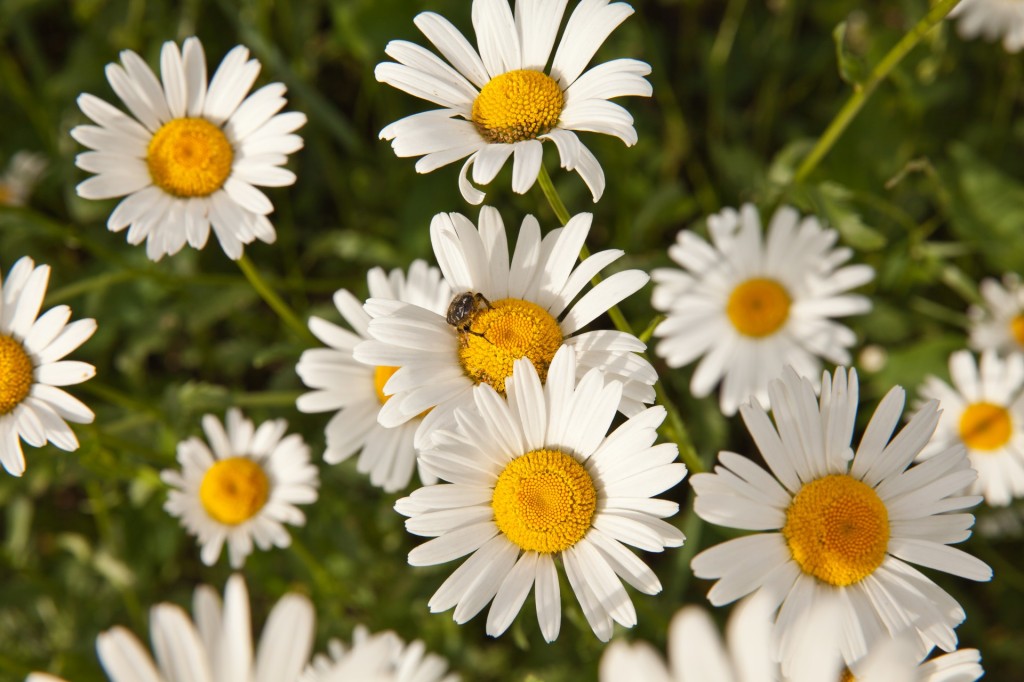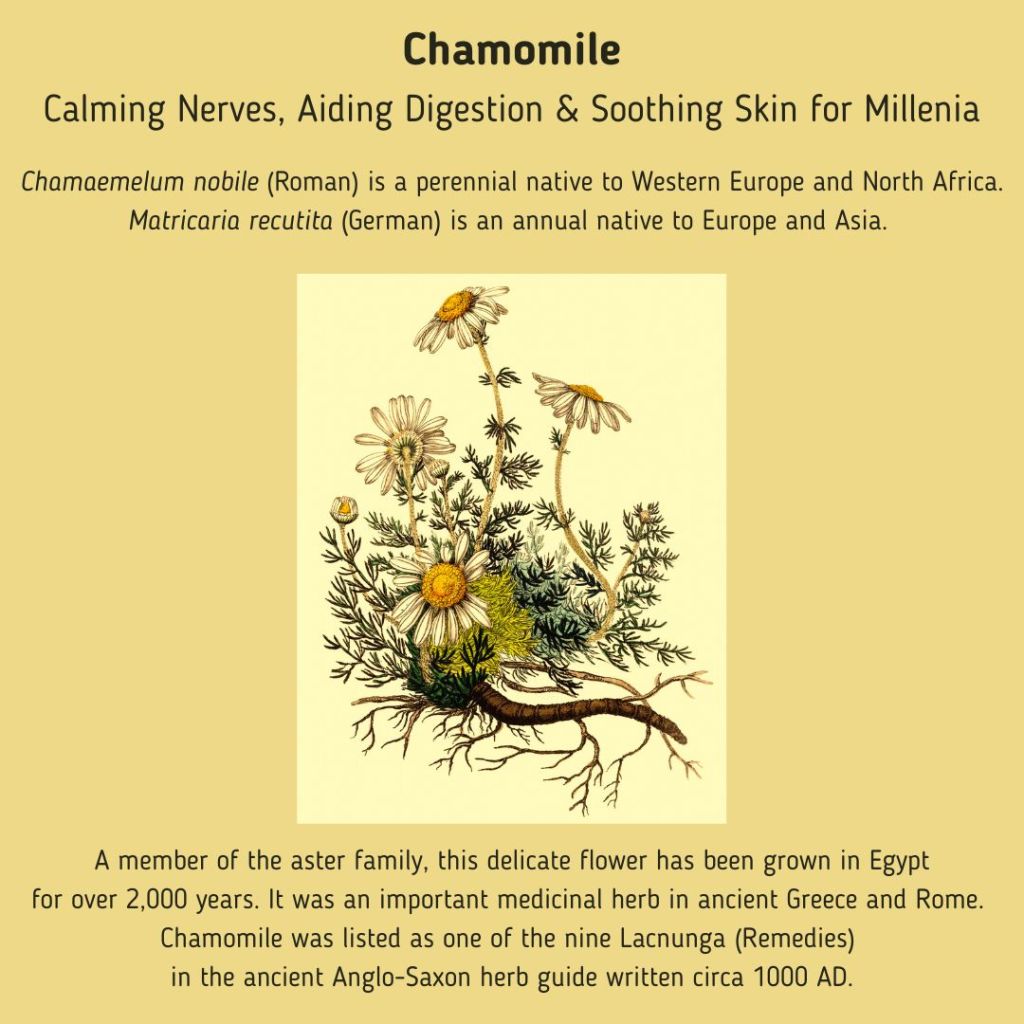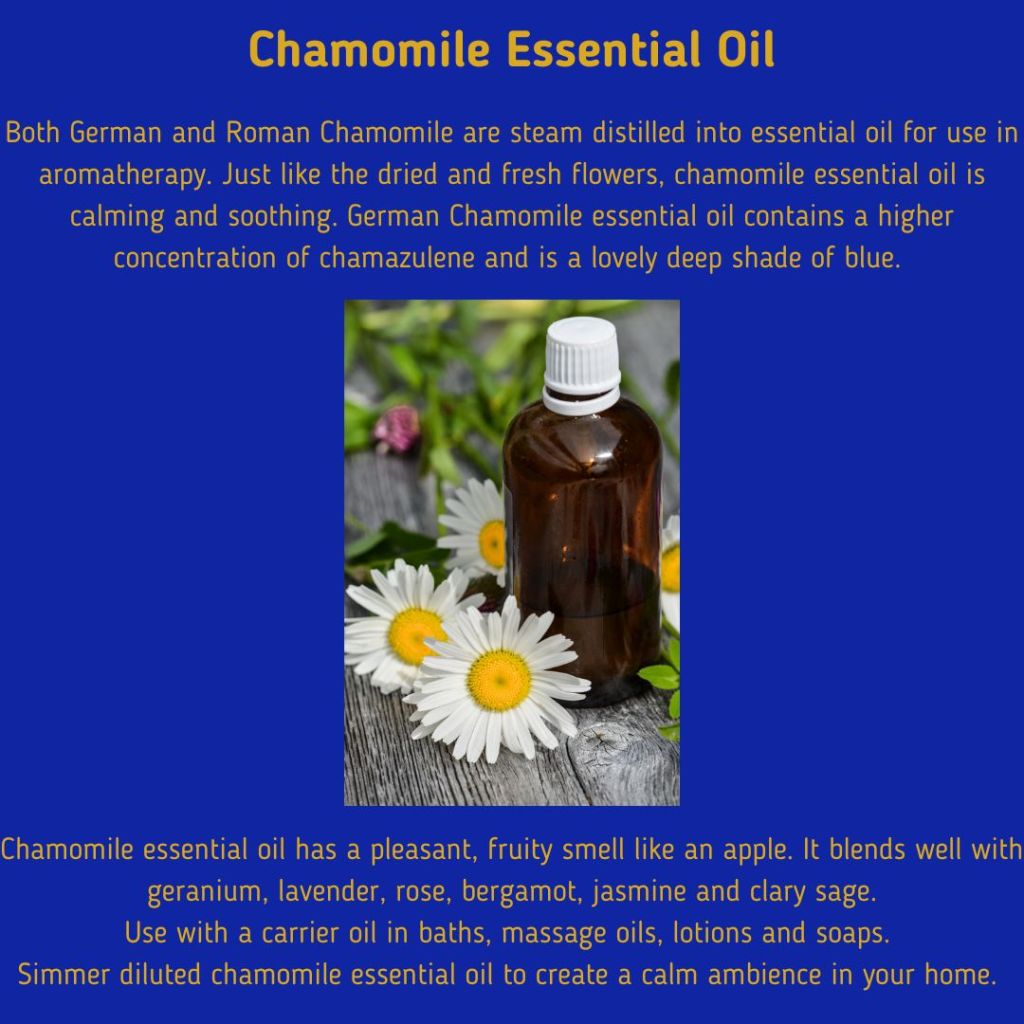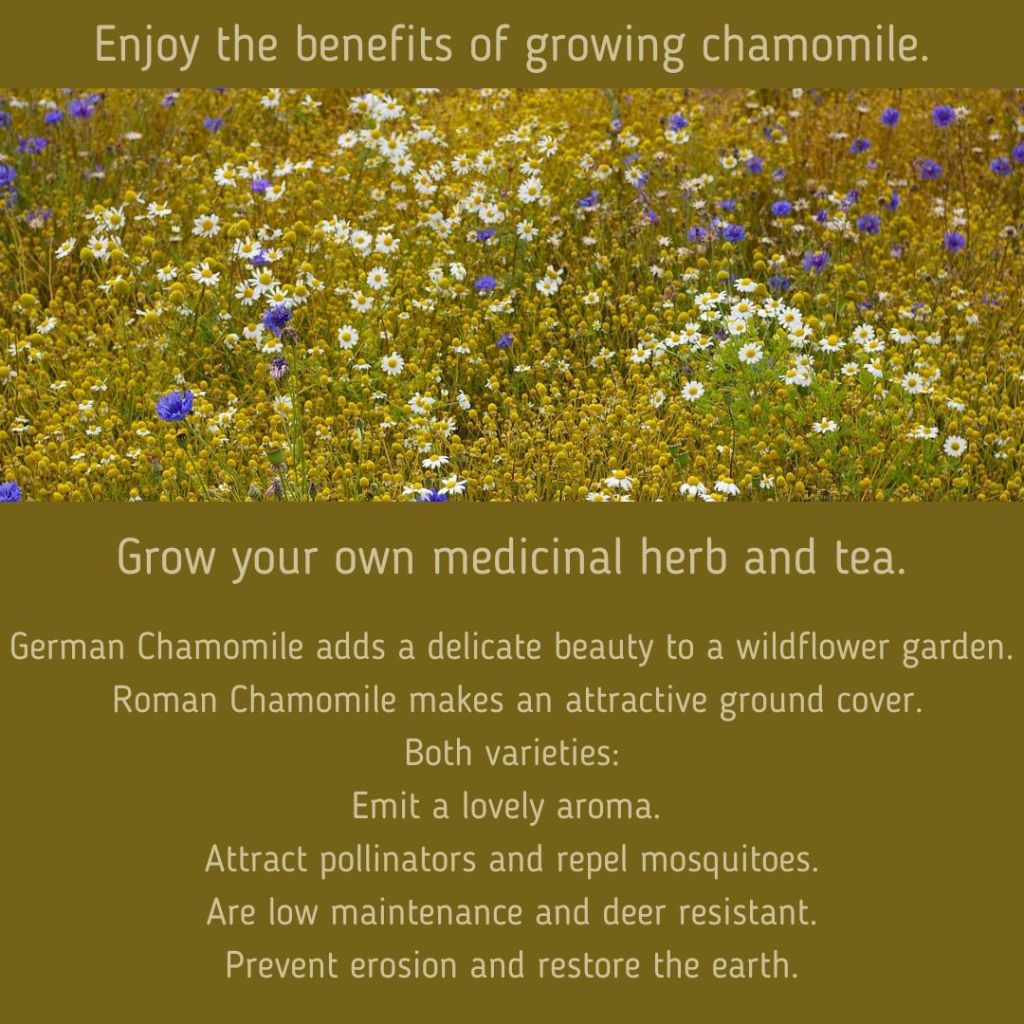Getting to Know Chamomile
I was introduced to chamomile in college. After senior seminar (anthropological theories), several of us gathered at our friend’s house for a cup of herbal tea, toast and talk. Steve’s bamboo filter held delicate dried flowers that released an earthy, sweet smell when he rubbed them between his fingers. While we discussed Clifford Geertz, the chamomile flowers steeped in hot water, creating an aromatic steam. Steve added a bit of honey and voila! – the brew was transformed into a golden elixir. Our relaxed conversation led to a better understanding of complex theories and a deep appreciation of one another. That afternoon tea proved to be a pivotal point in my life. I pursued graduate studies in anthropology and was fortunate enough to attend a lecture presented by Clifford Geertz. Chamomile tea soothed my jangled nerves after exams and all-night study sessions. Calm nerves foster clear thoughts.
To make your own chamomile tea (infusion), use 1 tablespoon dried chamomile flowers for each cup of tea. After the water has boiled, steep in hot water for 7 – 10 minutes. (Do not boil chamomile tea.) Strain and add honey if desired.
Later I learned to diffuse chamomile, creating a soft, sweet smell and calm ambience in my home. Steaming herbs freshens stale air like a summer breeze. I also added chamomile essential oil and dried flowers to my bath and homemade soaps and lotions. When we put our house on the market, I added chamomile and lemon to my floor cleaner to elevate the mood of potential buyers (and us). To this day, I keep dried chamomile in a little bowl in our guest room for a good night’s sleep. To freshen the dried herbs, I periodically add a few drops of chamomile essential oil.
Understanding Chamomile
Chamomile plants are native to Western Europe and Northern Africa. Today it is grown all around the world in temperate regions. Chamomile is primarily cultivated in England, France, Belgium, Germany, Poland, Hungary, Bulgaria, Egypt, and Argentina.
Chamomile, a member of the Aster Family (Asteraeae) is a sweet, delicate flower with white florets and yellow centers – like small happy faces. The scent is reminiscent of apple or pineapple. Chamomile is derived from the Greek words kamai (on the ground) and melon (apple). There are many varieties; the most widely used are German (Matricaria recutita) and Roman (Chamaemelum nobile).
Roman Chamomile is a low-growing perennial that grows to approximately 10 inches high. It has one flower on each hairy stem.
German Chamomile is an annual that grows up to 24 inches with fern-like foliage and branching stems with several flowers on each stem.
Both varieties are used interchangeably, although there are subtle differences in taste and action. Some claim that Roman Chamomile is milder, making it more suitable for those that have more sensitive skin or easily upset digestive systems. German Chamomile is more commonly used in herbal teas. Many products containing chamomile use a combination of both varieties.
Chamomile was cultivated in ancient Egypt where it was used both medicinally and cosmetically. Egyptian noblewomen crushed chamomile flowers and applied them to their skin to maintain a youthful glow. Offerings of the flower were made to the powerful sun god Ra and the plant’s oil was used to anoint the dead. Just as we do, the ancient Greeks and Romans drank chamomile tea and used the herb to treat skin conditions and other ailments.
In the 10th century, the Anglo-Saxons recorded 200 treatments in Lacnunga (Remedies). This precious document is still housed in the British Library! They held nine herbs to be most sacred: mugwort, plantain, watercress, chamomile, nettle, crab apple, chervil and fennel. To create a salve, all nine herbs were powdered, mixed with old soap, made into a paste with lye, and mixed with boiled fennel. The sterile salve was used to treat geblæd, a skin infection or inflammation.
To this day, people around the globe value chamomile for its therapeutic properties. Chamomile promotes restful sleep, relieves pain and elevates one’s mood. It is gentle enough for babies, yet strong enough for adults. It is one of the more popular herbal teas; people drink over a million cups of chamomile tea a day, often in the evenings before bed. Because of its popularity and uses in traditional medicine, chamomile has been studied more than other herbs. According to Janmejai K. Srivastava and Sanjay Gupta, the dry flower of chamomile contains approximately 120 secondary metabolites, comprising terpenoids and flavonoids, which contribute to its medicinal properties.
Benefits of Chamomile
Over the centuries, chamomile has been a popular home remedy and recent studies have reaffirmed its efficacy for a number of common ailments. Follow the links below to learn more.
- Promotes sleep and reduces stress, depression and anxiety.
- Eases digestive issues, including indigestion, diarrhea, nausea and gas.
- Heals wounds including ulcers and sores.
- Relieves pain related to osteoporosis, arthritis, headaches, back pain and neuralgia.
- Modulates inflammation.
- Soothes skin irritation and promotes skin health.
- Reduces symptoms of common cold.
- Promotes oral health.
Beyond Tea
Chamomile can be used as a bulk dried or fresh herb, essential oil, dry powder, tincture, bath or massage oil. It is used commercially in soaps, lotions, shampoos and more. According to a recent New York Times Style Magazine article, chamomile is more popular than ever and for an even wider variety of uses – from wedding cake decorations to cocktails and mocktails to savory and sweet dishes to natural dyes. Chamomile’s delicate flowers and fern-like foliage are favored in whimsical, nostalgic bouquets.
The flower heads of chamomile are steam distilled into a concentrated essential oil with a pleasant, sweet yet warm odor. Roman Chamomile oil has a very pleasant, soothing, apple-like aroma and is milder than German Chamomile. German Chamomile has a high content of azulene, the active organic compound of chamomile, which creates an inky blue color with a strong sweet and warm fragrance. Both Roman and German Chamomile essential oils blend well with geranium, lavender, rose, bergamot, jasmine and clary sage.
When you purchase chamomile essential oil, check the Latin name to make sure you are buying the type you want. You can learn by buying a small amount of each or sample them at an herbal store. Check for purity standards and make sure they are stored in dark bottles. Because essential oils are concentrated, use with a carrier oil (olive, coconut, almond, etc.).
Enjoy making your own products like my recipe below:
Chamie’s Kisses Facial Toner
Combine ¾ cup aloe vera gel, ¾ cup ground chamomile flowers infused in apricot oil then strained, essential oils of chamomile & grapefruit to make a nourishing and refreshing facial toner. Dab a bit on your face with a cotton ball.
To learn more about essential oils, read my post, Ayurvedic Aromatherapy.
Please note: Chamomile is not for everyone. Some people who are sensitive to the Aster Family will also be sensitive to chamomile. Always seek advice from a professional before using a plant medicinally.
Chamomile in the Garden
Chamomile is a lovely addition to any garden. As companion plants, chamomile can prevent fungal and bacterial infections in the plants around them. They also repel many insect pests. I have grown German Chamomile for a number of years. This variety grows three feet tall so is lovely in a wildflower meadow. The delicate leaves are fern-like light green, and the cheerful flowers make a lovely bouquet in my planter. Today I picked some fresh flowers for a smell test. I think they smell earthy yet fruity; my husband smelled the fresh air of the ocean.
Roman Chamomile is the best choice for an eco-friendly lawn substitute. It grows in zones 4 – 9 and blooms from June to September. Plant it after all danger of frost has passed and ensure the area is weed-free. The seeds have a slow germination period, so are best started indoors then transplanted outside.
Roman Chamomile can flourish in full sun or dappled shade in well-drained or sandy soil. It is moderately drought tolerant with a low risk of disease or pests. This perennial grows 3 – 6 inches tall with thicker, flatter leaves. Each plant spreads to 12 inches wide. Imagine walking barefoot and releasing the flowers’ sweet aroma with every step?! For that very reason, chamomile was planted along garden paths as a strewing herb in the Middle Ages. (Avoid walking on your flower lawn until the plants are well-established.)
A chamomile lawn is low maintenance, it only requires dead heading the flowers in late summer. That can be down with a mower on the highest setting. You can buy Treneague, a nonflowering cultivar of Roman Chamomile. It won’t require as much trimming as flowering varieties. Young plants need 1 inch of water every week. As they mature, they require less water. Chamomile not only creates a lovely lawn, but it also controls erosion..
Around our yard in sandy, disturbed soil Wild Chamomile or Mayweed (Matricaria discoidea) grows in the spaces between gravel. In an attempt to create a wild groundcover, I have been moving plants one by one with mixed success. Wild Chamomile has a small yellow flower head but lacks white petals. To me, it smells like pineapple.
Caution: avoid planting too much chamomile where dogs and cats can munch on it, since in excess it can be toxic.















